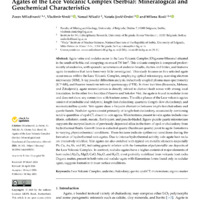Agates of the Lece Volcanic Complex (Serbia): Mineralogical and Geochemical Characteristics
Објеката
- Тип
- Рад у часопису
- Верзија рада
- објављена верзија
- Језик
- енглески
- Креатор
- Zoran Miladinović, Vladimir Simić, Nenad Nikolić, Nataša Jović Orsini, Milena Rosić
- Извор
- Minerals
- Издавач
- MDPI AG
- Датум издавања
- 2024
- Сажетак
- Agate veins and nodules occur in the Lece Volcanic Complex (Oligocene-Miocene) situated in the south of Serbia and occupying an area of 700 km2. This volcanic complex is composed predominantly of andesites, with sporadic occurrences of andesite-basalts, dacites and latites, and features agate formations that have been very little investigated. This study focuses on five selected agate occurrences within the Lece Volcanic Complex, employing optical microscopy, scanning electron microscopy (SEM), X-ray powder diffraction analysis, inductively coupled plasma mass spectrometry (ICP-MS), and Fourier transform infrared spectroscopy (FTIR). In three localities (Rasovača, Mehane, and Ždraljevići), agate mineralization is directly related to distinct fault zones with strong local brecciation. In the other two localities (Vlasovo and Sokolov Vis), the agate is found in nodular form and does not show any connection with fracture zones. The silica phases of the Lece volcanic agates consist of cristobalite and tridymite, length-fast chalcedony, quartzine (length-slow chalcedony), and macrocrystalline quartz. Vein agates show a frequent alternation between length-fast chalcedony and quartz bands. Nodular agates consist primarily of length-fast chalcedony, occasionally containing notable quantities of opal-CT, absent in vein agates. Microtextures present in vein agates include crustiform, colloform, comb, mosaic, flamboyant, and pseudo-bladed. Jigsaw puzzle quartz microtexture supports the recrystallization of previously deposited silica in the form of opal or chalcedony from hydrothermal fluids. Growth lines in euhedral quartz (Bambauer quartz) point to agate formations in varying physicochemical conditions. These features indicate epithermal conditions during the formation of hydrothermal vein agates. Due to intense hydrothermal activity, vein agate host rocks are intensively silicified. Vein agates are also enriched with typical ore metallic elements (especially Pb, Co, As, Sb, and W), indicating genetic relation with the formation of polymetallic ore deposits of the Lece Volcanic Complex. In contrast, nodular agates have a higher content of major elements of host rocks (Al2O3, MgO, CaO, Na2O, and K2O), most probably mobilized from volcanic host rocks. Organic matter, present in both vein and nodular agate with filamentous forms found only in nodular agate, suggests formation in near-surface conditions.
- том
- 14
- Број
- 5
- почетак странице
- 511
- doi
- 10.3390/min14050511
- issn
- 2075-163X
- Subject
- Lecki vulkanski kompleks, andeyit, kalcedon, kvarc, opal-CT, mikrostruktura, organska materija
- Lece Volcanic Complex, andesite, chalcedony, quartz; opal-CT, microtexture, organic matter
- Шира категорија рада
- M20
- Ужа категорија рада
- М22
- Права
- Отворени приступ
- Лиценца
- Creative Commons – Attribution 4.0 International
- Формат
- Медија
 minerals-14-00511.pdf
minerals-14-00511.pdf
Zoran Miladinović, Vladimir Simić, Nenad Nikolić, Nataša Jović Orsini, Milena Rosić. "Agates of the Lece Volcanic Complex (Serbia): Mineralogical and Geochemical Characteristics" in Minerals, MDPI AG (2024). https://doi.org/10.3390/min14050511 М22
This item was submitted on 15. мај 2024. by [anonymous user] using the form “Рад у часопису” on the site “Радови”: http://drug.rgf.bg.ac.rs/s/repo
Click here to view the collected data.